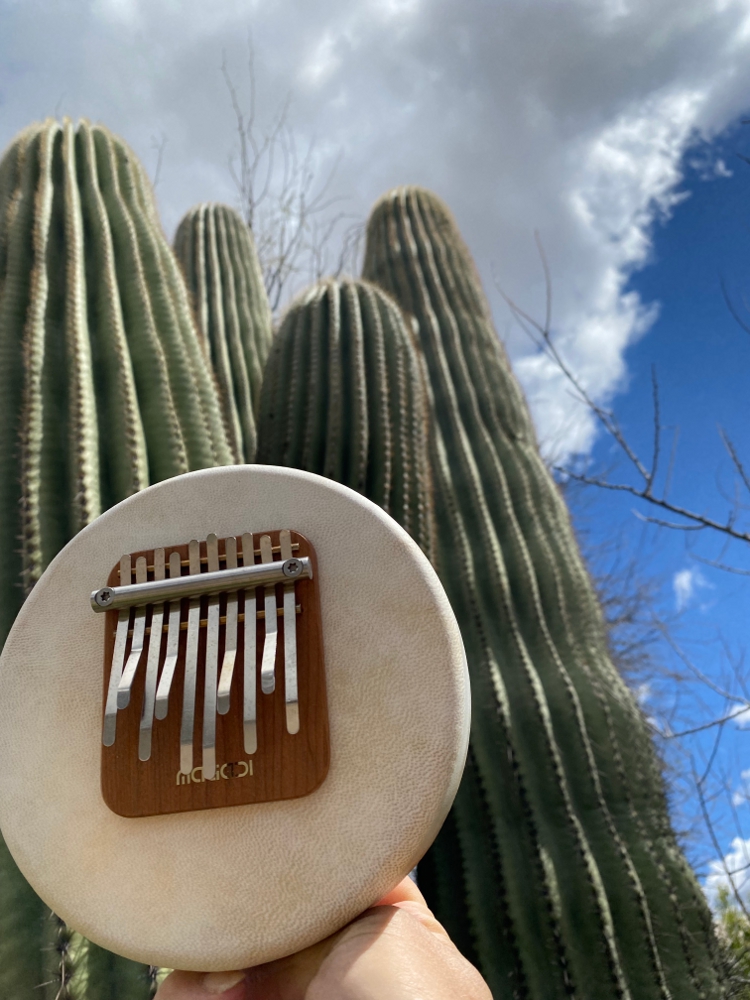
Use of this website constitutes acceptance of the Privacy Policy and User Agreement. Copyright © 2020 Kalimba Magic. All Rights Reserved.
Why do people acquire kalimbas in different keys? To be able to support specific songs they or others sing, or to be able to play with other musicians with flexibility. Sometimes people buy a kalimba in some particular key just because they really love its sound.
But can you use kalimbas in different keys together? By creating a simple song that uses different-keyed kalimbas, not played together but in succession, yes you can!
Listen to the music that plays automatically when you load this page. The first notes are from the D Treble kalimba, and it is always heard on the far left.
The next kalimba you hear is the Bb Treble kalimba, mixed to the center.
The third kalimba you hear is the Treble kalimba in standard G tuning, heard on the far right.
That cycle (the D Treble on the left, the Bb Treble in the center, and the G Treble on the far right) is repeated over and over again in this music, and it is the organizing principle of the music.
Note that even though I am playing three kalimbas here, this cycle is “square” — four measures long. I play the first two kalimbas for one measure each, and the third kalimba plays two measures, totaling four measures.
One, two or three people could participate in playing three kalimbas. As you’ll see, what looks complicated is really not.
Whatever the first kalimba plays in D, the second kalimba copies this exact pattern in Bb. Of course, the different tunings don’t have the same notes – but we copy whatever pattern the first kalimba played, referenced to the painted tines, and referenced to the root note. Ditto for the third kalimba, except its part is played two times to fill up its two measures. Playing in this way, the three kalimbas create music that transposes the first kalimba player’s music into descending keys, from D to Bb to G.
Playing with differently tuned kalimbas in this way, there are many notes on one kalimba that could clash with the notes on the other kalimbas. Our first goal is to avoid those clashes, and taking turns playing the different instruments is a simple way to do that. If the notes from one kalimba overlap those of another, make sure the overlapping notes harmonize. If they don’t harmonize, look for another note to play in that position, or just make sure one kalimba player stops before the next one starts to copy the phrase.
In a song like this, most of the expressive work belongs to the player of the first kalimba in the cycle, as the other two kalimbas are just copying the part of the first one (but shifted down to their key). As the leader, the player of the first kalimba should hold the goal of growing and expanding the first phrase, potentially changing it along the way, and eventually doing something to signify the end of the song. Thus the song’s “growth arc” can keep the music moving forward and keep it engaging to both the players and the listeners.
The harmony of the music you are hearing now is closely dependent upon the keys of the three kalimbas we are playing – D, Bb, and G. Other kalimba keys or tunings would have produced a different musical effect. In other words, there are hundreds of untried different groupings of kalimbas in different keys that can make beautiful and interesting music.
And while we’re here, why not make it easy for you to get three different Treble kalimbas in tunings of your choice, at a significant discount?
Introducing: the Treble Trio, only available at Kalimba Magic.


Sign up for our newsletter and free resources with your email address:
We pinky promise not to spam you and to only send good stuff.
 Assist Paul Tracey Rebuild His House in Pacific Palisades
Assist Paul Tracey Rebuild His House in Pacific Palisades 8-Note Spiral Kalimba Turned into a Student Karimba
8-Note Spiral Kalimba Turned into a Student Karimba Seek to Infuse Your Musical Moments With Beauty and Magic
Seek to Infuse Your Musical Moments With Beauty and MagicUse of this website constitutes acceptance of the Privacy Policy and User Agreement. Copyright © 2020 Kalimba Magic. All Rights Reserved.